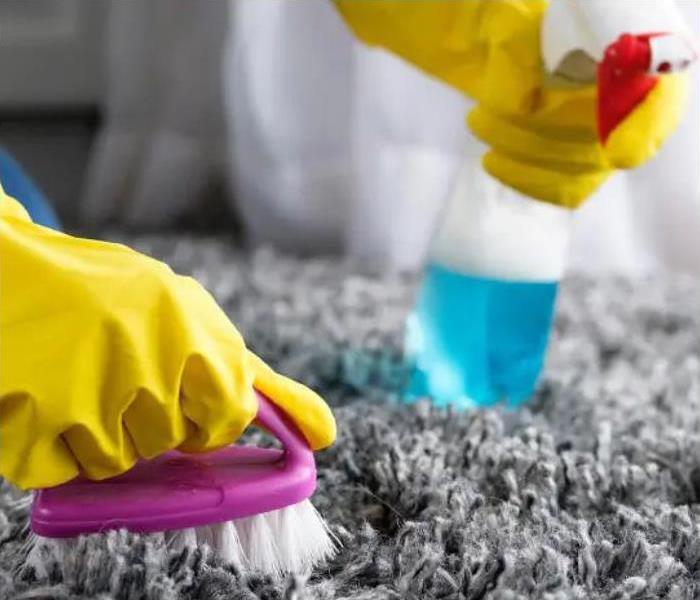Get Mildew Smell Out of Carpet in 6 Steps
2/2/2024 (Permalink)
 Whether it's due to spills, leaks, humidity, or lack of ventilation, it’s important to get that mildew smell out of the carpet as soon as possible.
Whether it's due to spills, leaks, humidity, or lack of ventilation, it’s important to get that mildew smell out of the carpet as soon as possible.
Step 1: Identify and Eliminate the Source
Locating the source of the odor is the first step in eradicating the mildew smell. Make sure the carpet is not damp. Check the walls and ceilings for signs of water damage or leaks. Don't forget to check under furniture.
Once the source is identified, fix any leaks or spills and thoroughly dry the area. It may be necessary to pull back the edges of the carpet or remove baseboards to allow air to circulate. Consider using a dehumidifier to eliminate moisture from the air and carpet.
Replace any water-damaged carpet padding to prevent the smell from coming back. If sections of the carpet itself are damaged, it may be necessary to cut them out and replace them.
Step 2: Vacuum the Carpet
Vacuum slowly and thoroughly, going over the entire carpeted area in overlapping passes. The vacuum may have special tools like a crevice attachment that can also come in handy for hard-to-reach areas where mildew lurks.
Empty the vacuum and wipe the filters after each use to prevent transferring mildew spores back to the carpet. You may need to vacuum a few times to get it all.
Just vacuuming won't remove the smell, but it helps by reducing mildew in carpet, making the rest of the process more efficient.
Step 3: Apply a Cleaning Solution
With the debris gone, the next step is to sanitize the carpet by applying a cleaning solution. Depending on your preference, you can use commercial carpet cleaning products or tried-and-true home remedies. If you prefer home remedies, here are some effective ones to try:
- Baking Soda/Salt: Generously sprinkle on the carpet and let it sit overnight, then vacuum.
- Alcohol: If the carpet isn’t too damp, high-proof cleaning alcohol is effective for addressing small to medium areas.
- Hydrogen Peroxide: Essentially a bleach, it must be diluted 20:1 with water and used on a completely dry carpet.
- Vinegar: An acidic, inexpensive, nontoxic solution. However, it has a strong odor and may cause skin irritation, so it should be handled with personal protective gear.
Step 4: Scrub the Carpet
For small areas, use an old scrub brush, toothbrush, or scrub pad. For larger areas, rent an electric carpet scrubber or steam cleaner. Apply the solution and scrub in small circles, working from the outside in. Let the solution sit for at least 30 minutes unless the label's instructions say otherwise.
After applying the cleaning product, use a towel or a wet/dry vac to absorb as much moisture as possible. Rinse thoroughly with water to remove any remaining residue. You may need to repeat this step a few times for tough stains. Be careful not to oversaturate the carpet with liquid.
Once you’re done scrubbing, open windows to ventilate and speed up the drying time. Running an air purifier with a HEPA filter can also help eliminate any remaining musty smells in the room.
Step 5: Let It Dry
Now that as much of the water as possible is soaked up, it’s time to let the carpet air dry completely.
Leave the windows open and use fans to speed up drying time. The faster the carpet dries, the less chance the mildew smell has to settle in and spread. Continue to circulate the air around the damp area with fans. Turn on any overhead or portable fans to keep the air moving.
Aiming a fan directly at the damp area of the carpet will speed up evaporation. For small, isolated areas, it may take 8 to 12 hours to dry the area completely. Wall-to-wall carpet or carpet in rooms with little air circulation may take 24 hours or longer to dry completely.
Leaving the carpet damp for too long allows mildew to grow rapidly. Prioritize drying the carpet quickly to avoid a full-on mildew infestation. Speedy drying, combined with the suggested cleaning steps, should leave the carpet mildew-free and smelling fresh again.
Step 6: Deodorize
Baking soda is a natural odor absorber that can help freshen the carpet. Sprinkle baking soda liberally over the entire carpeted area. Let it sit for at least a few hours or overnight. The baking soda should absorb the mildew and musty smells from the carpet.
Vacuum the baking soda thoroughly using the hose or brush attachment on the vacuum. You may need to go over the area a few times to pick up all the baking soda granules.
For tough smells, try using activated charcoal, which is very porous and effective at absorbing odors. Place containers of activated charcoal around the room. Replace or refresh the charcoal every month or so.
Commercial carpet deodorizers and powders can also help eliminate odors. Look for natural, fragrance-free products, and always follow the directions carefully. Reapply as needed until the musty smell has disappeared.





 24/7 Emergency Service
24/7 Emergency Service